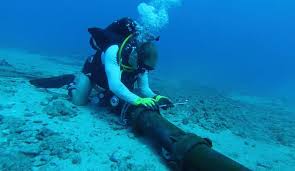
Houthi submarine cable attack in 2005 Introduction
Houthi submarine cable attack in 2005 Recently, undersea cables in the Red Sea—vital for global internet traffic—were cut, disrupting connectivity across Asia and the Middle East. With Yemen’s Houthi rebels active in the region, suspicion quickly turned toward them. This article investigates whether the Houthis actually attacked the submarine cables, examining evidence, denials, technical factors, and the broader geopolitical context.
What Happened: The Red Sea Cable Disruptions Houthi submarine cable attack in 2005
In early September 2025, multiple undersea fiber-optic cables in the Red Sea were severed—specifically the SMW4, IMEWE, and FALCON GCX systems—causing widespread internet slowdowns in countries like India, Pakistan, Saudi Arabia, Kuwait, UAE, and beyond.
Houthi submarine cable attack in 2005 Microsoft and connectivity monitors such as NetBlocks confirmed increased latency and degraded access—especially to cloud and network services routed through the region.Who’s Being Blamed—and What They Say

1. Yemen’s Government-in-Exile
Yemen’s internationally recognized government, opposed to the Houthis, has firmly condemned the incident, stating:
2. Houthis’ Response
The Houthi rebels have denied involvement in attacks on submarine cables—both now and in past incidents.Houthi submarine cable attack in 2005 While Houthi-run media acknowledged the cable cuts occurred, they stopped short of claiming responsibility.
Could the Houthis Actually Do It?
Technical Limitations
Subsea cables rest deep beneath the sea surface—cutting them requires sophisticated equipment and precise operations. Experts point out that the Houthis lack known underwater sabotage capabilities Houthi submarine cable attack in 2005 .
Accidental Damage by Drifting Ships
Some evidence points to unintentional causes. In early 2024, the cargo vessel Rubymar was attacked, abandoned, and rented by currents—its dragging anchor believed to have severed three undersea cables in the Bab-el-Mandeb Strait.
Pattern of Disruption
Previous incidents—including cuts to AAE-1 and PEACE cables—show a pattern of damage linked to regional instability rather than intentional sabotage.
Why the Houthis are Suspected
There are several reasons why the Houthis are under scrutiny:
Conflict Zone Context: The Red Sea has seen intense Houthi activity against shipping and Israel, heightening suspicion
- Strategic Vulnerability: Red Sea cables carry massive amounts of Europe–Asia data, making them attractive targets for disruption.
Impact of the Disruption
Internet Slowdowns: Users across the Middle East and South Asia experienced degraded connectivity, cloud service delays, and disrupted business operations Houthi submarine cable attack in 2005.
epair Challenges: Fixing a damaged cable often takes weeks. Repair vessels must locate and access the damage site—logistically complex and costly
The Geopolitical Lens
Regional Conflict Escalation
The attack on cables could serve Houthi strategic goals—pressuring Israel over the Gaza conflict—though they deny it. The Red Sea remains a hotspot for proxy conflict.
Global Infrastructure Risks
Cable disruptions underscore how vulnerable global digital infrastructure is during geopolitical crises—sparking discussions about redundancy and protection.
Q1: Did the Houthis actually cut the cables?
There is no direct evidence. While in the crosshairs, the Houthis have denied involvement, and technical analysis points to accidental damage by a drifting ship’s anchor
Q2: Can the Houthis cut undersea cables intentionally?
Experts argue the Houthis lack the underwater capabilities needed for precise sabotage, making unintentional damage more plausible
Q3: How long will repairs take?
Repairs depend on locating the fault, permissions, and ship availability. Past cases like the PEACE cable saw a three-week restoration, while others took monthsv
Conclusion
While suspicion points toward the Houthis, there is no concrete proof they intentionally cut undersea cables. The more likely scenario involves accidental damage, possibly from drifting, abandoned vessels like the Rubymar. The incident, nonetheless, underscores the fragility of global digital infrastructure and the geopolitical risks surrounding undersea connectivity.
If a submarine cable accident—such as damage, severing, or disruption—were to occur and significantly impact Microsoft’s operations, the financial repercussions could indeed be enormous. While it’s difficult to tie an exact figure to Microsoft’s specific losses, we can estimate the range based on general data about the economic cost of such outages.
Economic Impact of Submarine Cable Disruptions
1. Global Cost Per Hour and Day
The International Cable Protection Committee (ICPC) estimates that underwater fiber-optic network interruptions can inflict losses exceeding $1.5 million per hour
On top of that, downtime across businesses globally can cost around $5,600 per minute. For example, disruptions in the Red Sea caused about $3.5 billion in economic losses
2. National-Level Cost Examples
A complete internet outage for one day globally could rack up losses of $43 billion, with the U.S. alone estimated to lose $11 billion, and China about $10 billion
A partial outage in Nigeria cost $593 million over just four days
Somalia’s economy lost around $10 million per day from a cable disruption
3. U.S.-Specific Cost Structure
In the U.S., submarine cable faults and repairs cost between $22 to $90 million annually, with indirect costs of $1.5 to $24 million per repair
Projected Microsoft-Specific Impact
As one of the world’s largest tech companies, Microsoft relies heavily on undersea cables for cloud services, Azure, Office 365, and enterprise connectivity.
If a cable disruption causes even a short-term outage impacting Microsoft’s services:
Hourly Losses
Applying the $1.5 million per hour figure as a baseline, a multi-hour outage could lead to tens of millions in losses—not just for Microsoft, but for its customers.
Daily Losses
Considering the broader economic impact (e.g. $43 billion global loss), Microsoft alone could be absorbing hundreds of millions, particularly across business-critical systems and enterprise disruptions.
Cumulative Multi-Day Damage
A scenario similar to Nigeria’s four-day loss (~$600 million) suggests Microsoft could face comparable or greater multihundred-million-dollar damage, possibly into the billion-dollar range if outages cascade across international services and partners.
Houthi submarine cable attack in 2005 Data Table: Estimated Microsoft Losses in a Submarine Cable Accident
| Timeframe | Estimated Microsoft Losses | Global/Economic Impact (Comparisons) | Company Name |
|---|---|---|---|
| Per Hour | $10M – $50M | $1.5M per hour average global cost (ICPC) | Microsoft outage per hour cost |
| 12 Hours | $120M – $600M | $18M+ global disruption cost | submarine cable accident impact |
| 1 Day (24 hrs) | $250M – $1B | $43B global loss in 1 day outage | Microsoft daily outage loss |
| 4 Days | $1B – $4B | Nigeria lost $593M in 4 days | cable cut losses multi-day |
| 1 Week (7 days) | $2B – $7B | Somalia lost $10M per day | submarine cable cut Microsoft |
| 1 Month (30 days) | $8B – $30B+ | U.S. economy risk: $11B/day outage | Microsoft cable disruption cost |


1 thought on “Houthi submarine cable attack in 2005”